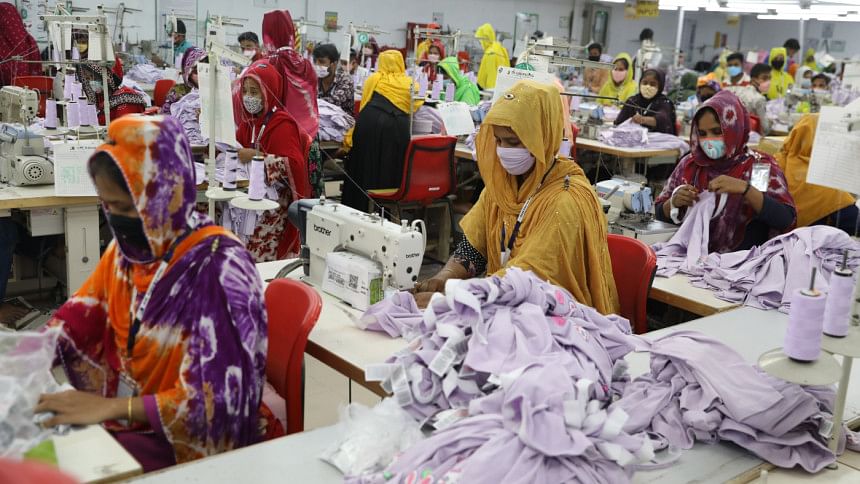Target for FY26 brings hope but exports remain stuck

The commerce ministry's ambitious $63.5 billion export target for FY26 brings hope, but exports remain stuck between global potential and long-standing domestic bottlenecks.
The real challenge is not competing with the world, it is dealing with problems at home, like gas shortages, customs hassles, banking crisis, and high interest rates.
From the readymade garments giants to emerging sectors like leather, agriculture, and plastic, the business community views the export target as achievable, but only if long-standing domestic bottlenecks are urgently addressed and global market access is preserved.
Of the total target, $55 billion is projected from goods exports,13.4 percent higher than the previous fiscal year, while $8.5 billion is expected from services exports, marking an ambitious 18.7 percent rise.
The recent changes in US tariff policy have given Bangladesh a comparative edge, particularly in the garments sector. With an average tariff rate of 36.5 percent, lower than those imposed on global market peers, the US market currently presents a rare opportunity for Bangladesh to boost its export footprint.
AK Azad, chairman of Ha-Meem Group, one of the country's largest RMG exporters to the US, said that while tariff advantages exist on paper, their practical impact is more complex.
"Yes, we have a window of opportunity, but we are also facing price pressure. Buyers are negotiating harder and offering to share the tariff burden."
Moreover, exporters warn against overdependence on any single market, even one as large as the United States.
"We have been disappointed before by sudden changes in rules. Even a new government could take away the tariff benefits in an instant," said an exporter from Chattogram who did not want to reveal their name.
Despite external advantages, exporters unanimously identify domestic obstacles, particularly energy shortages, banking sector crisis, and customs hurdles, as the biggest threats to achieving the FY26 export target.
Mohammad Hatem, president of the Bangladesh Knitwear Manufacturers and Exporters Association (BKMEA), stated: "There is demand in the global market. We are competitive. But how can we meet increased orders when gas supply is irregular, factories face sudden power outages, and LC processing is delayed due to a broken banking system?"
However, he said the industry is prepared to do more than the target as they achieved capacity.
Exporters say the energy crisis has already led to lost production hours and increased costs. They warn that without an uninterrupted energy supply, especially for energy-intensive sectors like textiles and leather, the FY26 target will remain out of reach.
Moreover, banking sector crisis and high interest rates have added to the burden. Exporters call for urgent reforms in banking governance and better access to affordable credit. Even if they do not feel comfort due to prolonged contractionary monetary policy, as it increases the cost of business.
While unveiling the export target, Commerce Secretary Mahbubur Rahman's announcement of a joint meeting next week with energy and banking sector stakeholders is being seen as a step in the right direction.
He assured that he would meet with exporters from 22 sectors to identify the major obstacles to achieving the target and work on resolving them.
The RMG sector, accounting for over 80 percent of goods exports, has been tasked with generating $44.49 billion,$20.79 billion from woven (14.3 percent growth) and $23.70 billion from knitwear (12 percent).
"There is appetite from the US and EU markets, especially with China gradually pulling back from low-end apparel. But we must act fast to scale up capacity and diversify designs," said Anwar-ul Alam Chowdhury Parvez, president of Bangladesh Chamber of Industries.
"But is the government creating this atmosphere to achieve the target, or to actually listen to exporters' problems?" he remarked.
Leather and leather goods have been given a $1.25 billion target, a modest 9.2 percent rise. Exporters in the sector say they are constrained by compliance issues, low-value raw exports, and infrastructure bottlenecks at the Savar Tannery Estate.
Nasir Khan, managing director of Jenys Shoe, said the sector has been hovering between $1 to $1.2 billion during the last two decades.
"I will be able to reach the target amount of leather footwear exports if customs simply do their job as facilitators, instead of acting like business destroyers at the port in the name of over-monitoring and taking bribes," he said.
Jute exporters are expected to bring in $900 million, up 9.7 percent. Industry insiders support the move to improve lab testing and invest in R&D, but demand faster implementation and better market access, especially in India, where trade policies remain volatile. But India imposed non-tariff barriers to enter in Indian market of jute goods.
The agriculture sector has a 22.4 percent growth target, totalling $1.21 billion. While producers agree there is global demand for Bangladeshi products, they are apprehensive about the achievement due to the continual declining trend of exports over the past three years.
One of the agro products exporters said if India reopens land ports, there is a possibility to achieve the expected growth; otherwise, it will be tough.
"There's nothing wrong with aiming high," said Hatem of BKMEA. "But this time, let's also do the hard work at home. If we fix the gas crisis, stabilise banking, and improve port logistics, you'll see, we won't just hit the target, we'll beat it."

 For all latest news, follow The Daily Star's Google News channel.
For all latest news, follow The Daily Star's Google News channel. 



Comments